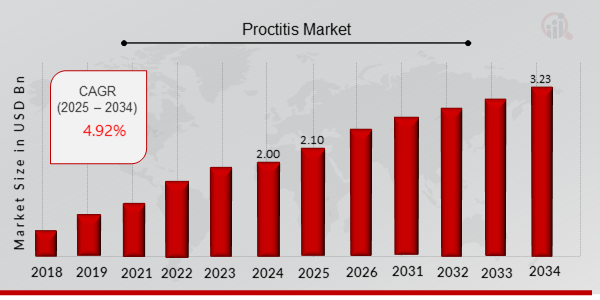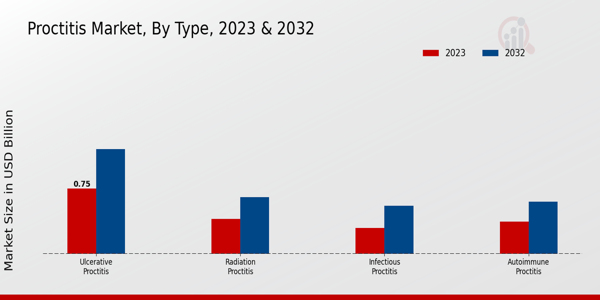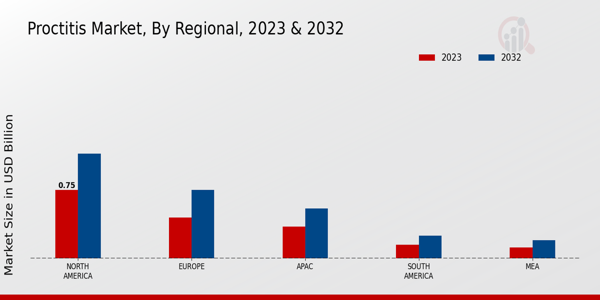Proctitis Market Overview
As per MRFR analysis, the Proctitis Market Size was estimated at 2.00 (USD Billion) in 2024. The Proctitis Market Industry is expected to grow from 2.10 (USD Billion) in 2025 to 3.23 (USD Billion) till 2034, at a CAGR (growth rate) is expected to be around 4.92% during the forecast period (2025 - 2034).
Key Proctitis Market Trends Highlighted
The Proctitis Market is growing as several market drivers continue to define its growth. The increasing incidence of gastrointestinal disturbances and rising public knowledge regarding bowel functioning are important drivers for the market. With more and more people being detected for such diseases, which likely lead to proctitis, the treatment demand now is increasing, too.
There is a demand for effective treatment options as more people are diagnosed with conditions that are likely to lead to proctitis. Increasing focus on patient care through advanced diagnostic procedures and new therapeutic measures is also observed among healthcare providers. The promotion of outreach programs by the government on the awareness of gastrointestinal diseases, together with rising healthcare costs, also serves competitive edge to the growth of the market.
Opportunities exist in the form of emerging treatment modalities that can address unsolved issues in proctitis management. There is a growing emphasis on personalized medicine and biologics that target specific patient populations, which presents a chance for innovation. Additionally, the potential for telemedicine and digital health solutions to manage chronic conditions offers an avenue for growth. The rising trend of patient engagement platforms can also contribute to better treatment adherence and monitoring. Furthermore, collaborations between pharmaceutical companies and research institutions are likely to yield new therapeutic approaches, expanding the market context.Trends in recent times indicate an increasing focus on understanding the underlying causes of proctitis. Researchers are exploring the links between lifestyle factors, diet, and the disease, which may lead to the development of preventive strategies. The use of digital tools for patient education is becoming more common, empowering patients to take active roles in their health management. As healthcare continues to evolve, a shift towards holistic approaches that include treatment along with lifestyle modifications is gaining traction. This evolution not only addresses the symptoms of proctitis but also emphasizes long-term wellness, making it a significant aspect of the current market landscape.

Source: Primary Research, Secondary Research, MRFR Database and Analyst Review
Proctitis Market Drivers
Increase in Prevalence of Inflammatory Bowel Diseases
The Proctitis Market Industry is experiencing notable growth driven by the increasing prevalence of inflammatory bowel diseases (IBD), such as ulcerative colitis and Crohn's disease. As these conditions lead to severe inflammation of the rectum and bowel, the demand for effective treatment options for proctitis is on the rise. The growing awareness and diagnosis of IBD have resulted in more patients being identified and treated for proctitis, which is often a complication of these diseases.Given the projected growth in the market from 2024 onwards, healthcare providers are compelled to develop advanced treatment options, including biologics and immunotherapy, to cater to this growing patient population. Additionally, the increasing adoption of digital health technologies and telemedicine solutions is aiding in the early detection and management of IBD-related proctitis, further contributing to market expansion. Overall, the interplay between the rising incidence of inflammatory bowel diseases and the evolving treatment landscape is expected to significantly bolster the Proctitis Market Industry in the coming years.
Advancements in Medical Technology
Advancements in medical technology play a crucial role in the growth of the Proctitis Market Industry. Innovations such as minimally invasive procedures, improved diagnostic tools, and targeted therapies are transforming the management of proctitis. The development of new endoscopic techniques and imaging modalities has enhanced the accuracy of diagnosis, enabling timely interventions. Furthermore, the introduction of biologics and advanced pharmacological treatments is providing patients with more effective options for managing inflammation and symptoms associated with proctitis.
Rising Awareness and Patient Education
Increased awareness and education regarding proctitis and associated health conditions contribute significantly to the growth of the Proctitis Market Industry. As health campaigns and educational programs become more prevalent, patients are more informed about the symptoms and treatment options available for proctitis. This rising awareness leads to higher patient engagement in seeking medical help and participating in preventive healthcare measures.Additionally, the endorsement of healthcare professionals and organizations in spreading awareness about the importance of early diagnosis and treatment is crucial in addressing the stigma associated with bowel diseases. The result is a growing patient population actively seeking treatment for proctitis, which indirectly supports market expansion.
Proctitis Market Segment Insights
Proctitis Market Type Insights
In 2023, the market's overall value reached 1.82 USD Billion, and it is projected to grow significantly by 2032. Among the various types of proctitis, Ulcerative Proctitis holds the majority share with a market valuation of 0.75 USD Billion, indicating its prominence due to the rising cases of inflammatory bowel disease (IBD). This segment demonstrates strong growth potential, reaching an estimated 1.2 USD Billion by 2032.Radiation Proctitis, valued at 0.4 USD Billion in 2023, also plays a critical role, particularly as more cancer patients undergo radiation therapy, with projections reaching 0.65 USD Billion in the coming decade. Infectious Proctitis, which had a market value of 0.3 USD Billion in 2023, reflects a growing concern related to sexually transmitted infections and gastrointestinal infections, potentially increasing its valuation to 0.55 USD Billion by 2032.
Lastly, Autoimmune Proctitis, valued at 0.37 USD Billion in 2023, highlights the need for therapies addressing autoimmunity in gastrointestinal conditions, with a future valuation of 0.6 USD Billion looming on the horizon. The segment's growth is notably fueled by advances in medical research and accessibility to healthcare, generating opportunities for market expansion.
Challenges, including treatment side effects and the need for personalized medicine, persist but are being actively addressed through ongoing research and development efforts. In summary, the Proctitis Market segmentation reveals a landscape of diverse types, with specific segments like Ulcerative and Radiation Proctitis driving major market revenues, while the overall market growth is supported by increasing awareness and advancements in treatment modalities.
Source: Primary Research, Secondary Research, MRFR Database and Analyst Review
Proctitis Market Treatment Insights
The Proctitis Market revenue for the Treatment segment was valued at 1.82 Billion in 2023 and is projected to grow significantly, reflecting the increasing prevalence of inflammatory bowel diseases. The market segmentation indicates that medications play a crucial role, often dominating the landscape due to their effectiveness in managing symptoms and promoting healing. Surgical interventions, though less common, are vital for severe cases, addressing complications that may arise. Dietary management and lifestyle changes are gaining traction as more patients recognize the importance of holistic approaches in treatment.These strategies not only enhance recovery but also improve quality of life, highlighting their significance in the Proctitis Market industry. The combination of medications and lifestyle interventions creates a well-rounded approach that caters to the diverse needs of patients, propelling market growth and supporting the development of innovative solutions to improve the management of proctitis. Other trends, such as increased awareness and research advancements, further drive the demand for comprehensive treatment options in this market context.
Proctitis Market Route of Administration Insights
The Proctitis Market, valued at 1.82 billion USD in 2023, features a diverse Route of Administration that plays a crucial role in treatment options for patients. Each method presents unique benefits and caters to different needs within the patient population. For instance, the Oral route maintains a significant share as it offers convenience and ease of administration, thus appealing to a larger group of patients seeking manageable treatment options. Topical administration is also vital, especially for localized treatment, providing direct relief to the inflamed areas while minimizing systemic side effects.Injectable solutions are particularly important for their rapid action and effectiveness in severe cases, ensuring that patients receive timely management of symptoms. The growth and diversification in these Routes of Administration reflect broader trends in the global healthcare landscape, where patient-specific treatment plans are increasingly prioritized to improve outcomes. Additionally, as the Proctitis Market evolves, ongoing research and development in formulation and delivery methods will likely open further opportunities and enhance the effectiveness of existing treatments.These aspects collectively underscore the importance of understanding the Route of Administration within the broader Proctitis Market revenue framework.
Proctitis Market Patient Population Insights
The Proctitis Market encompasses a diverse Patient Population, projected to reach a valuation of 1.82 billion USD in 2023. The market segmentation highlights key demographics, particularly within the adult and pediatric categories. Adults comprise a significant portion of the patient population, attributed to lifestyle factors and increasing rates of conditions such as inflammatory bowel diseases that lead to proctitis. Pediatric cases, while less frequent, are critical as they involve unique treatment protocols and long-term management strategies that differ significantly from adult care.The growing awareness of gastrointestinal health and advancements in diagnostic tools contribute to the rising prevalence of proctitis in these age groups, presenting both challenges and opportunities for healthcare providers. Current Proctitis Market data illustrates an upward trend in treatment options driven by the need for effective management of this condition, with statistics suggesting a robust growth trajectory driven by ongoing research and development within the industry. Understanding the composition of the Patient Population is vital for stakeholders aiming to cater to specific needs and enhance therapeutic efficacy in both adults and children.
Proctitis Market Regional Insights
The Proctitis Market is poised for growth across various regions, reflecting significant market dynamics. In 2023, North America emerged as the leader with a valuation of 0.75 USD Billion, and it is expected to exhibit robust growth, reaching 1.15 USD Billion by 2032. This region dominates due to advanced healthcare infrastructure and higher prevalence rates, contributing to a majority holding in global revenue. Europe follows with a market valuation of 0.45 USD Billion in 2023 and is projected to grow to 0.75 USD Billion by 2032, driven by increasing awareness and improved diagnosis.The APAC region, valued at 0.35 USD Billion in 2023, is anticipated to grow to 0.55 USD Billion by 2032, showcasing a significant rise fueled by rising healthcare investments and population growth. South America and MEA represent smaller segments, valued at 0.15 USD Billion and 0.12 USD Billion in 2023, respectively, with projections of 0.25 USD Billion and 0.20 USD Billion by 2032. While these regions currently hold the least market share, they possess emerging opportunities driven by increasing healthcare access and a growing focus on gastrointestinal disorders.

Source: Primary Research, Secondary Research, MRFR Database and Analyst Review
Proctitis Market Key Players and Competitive Insights
The Proctitis Market represents an intricate landscape characterized by a range of products and treatment modalities targeting inflammatory bowel diseases, particularly proctitis. As the prevalence of inflammatory bowel disease continues to rise globally, the market is witnessing an uptick in demand for effective management solutions for proctitis. Competitive insights into this market reveal that various pharmaceutical giants are investing significantly in research and development efforts to innovate treatments that enhance patient outcomes. The competitive dynamics are influenced by factors such as the introduction of novel therapies, collaborations between biotech firms and research institutions, as well as an increasing focus on personalized medicine. Moreover, the regulatory landscape and reimbursement policies in different regions also play a vital role in shaping the market strategies of the key players operating within this domain.Merck and Co. has established a commendable presence in the Proctitis Market due to its significant research capabilities and robust product pipeline. The company is recognized for its commitment to addressing unmet medical needs, especially in the therapeutic areas of gastroenterology. Merck and Co's strength lies in its extensive experience in developing groundbreaking biologics and small molecule therapies that target the underlying mechanisms of inflammatory bowel diseases, including proctitis. With a well-defined strategy to enhance patient access to innovative therapies, the company has made substantial investments in clinical trials aimed at validating the efficacy and safety of its offerings. Furthermore, their strong market position is augmented by strategic collaborations and partnerships that allow for the sharing of resources and knowledge, ultimately boosting their ability to bring new products to market swiftly and efficiently.Takeda Pharmaceutical also commands a significant position within the Proctitis Market, focusing on advancing treatment options for gastrointestinal disorders. The company has garnered respect for its deep-rooted expertise in immunology and gastroenterology, positioning itself as a key player in developing therapies that cater specifically to patients suffering from proctitis. Takeda Pharmaceutical's approach hinges on a patient-centric philosophy that informs its product development, ensuring that new therapies are aligned with the real-world challenges faced by patients. They emphasize a strong commitment to innovation through investment in advanced research technologies and global clinical trial initiatives. Their extensive portfolio, complemented by an agile approach to market entry strategies, enables Takeda Pharmaceutical to be responsive to evolving market needs, thus reinforcing its competitive advantage in the Proctitis Market.
Key Companies in the Proctitis Market Include
- Merck and Co
- Takeda Pharmaceutical
- Pfizer
- Amgen
- Ferring Pharmaceuticals
- Celgene
- AbbVie
- Sandoz
- Roche
- Sanofi
- AstraZeneca
- Bristol-Myers Squibb
- Gilead Sciences
- Johnson and Johnson
Proctitis Market Industry Developments
Recent news developments in the Proctitis Market indicate a sustained interest among major pharmaceutical companies, including Merck & Co., Takeda Pharmaceutical, Pfizer, and AbbVie, as they continue to invest in research and development to address the increasing prevalence of proctitis and related gastrointestinal disorders. Takeda has recently expanded its portfolio for gastrointestinal conditions, enhancing its market position.
Meanwhile, Pfizer has made advancements in drug efficacy for inflammatory bowel diseases, which can include proctitis as a complication. Additionally, Amgen and Roche are exploring new biological therapies that target key pathways involved in gastrointestinal inflammation, potentially providing novel treatments for patients. In terms of mergers and acquisitions, there have been reports of collaborative efforts among Gilead Sciences, Johnson & Johnson, and Bristol-Myers Squibb aimed at enhancing their research capabilities in inflammatory diseases, although no specific acquisitions have been finalized recently. Market growth is further fueled by an increasing patient population and heightened awareness, creating a competitive landscape that encourages collaborations and new solutions in the proctitis space.
Proctitis Market Segmentation Insights
- Proctitis Market Type Outlook
- Ulcerative Proctitis
- Radiation Proctitis
- Infectious Proctitis
- Autoimmune Proctitis
- Proctitis Market Treatment Outlook
- Medications
- Surgery
- Dietary Management
- Lifestyle Changes
- Proctitis Market Route of Administration Outlook
- Proctitis Market Patient Population Outlook
- Proctitis Market Regional Outlook
- North America
- Europe
- South America
- Asia-Pacific
- Middle East and Africa
| Report Attribute/Metric |
Details |
|
Market Size 2024
|
2.00 (USD Billion)
|
|
Market Size 2025
|
2.10 (USD Billion)
|
|
Market Size 2034
|
3.23 (USD Billion)
|
|
Compound Annual Growth Rate (CAGR)
|
4.92 % (2025 - 2034)
|
|
Report Coverage
|
Revenue Forecast, Competitive Landscape, Growth Factors, and Trends
|
|
Base Year
|
2024
|
|
Market Forecast Period
|
2025 - 2034
|
|
Historical Data
|
2020 - 2024
|
| Market Forecast Units |
USD Billion |
| Key Companies Profiled |
Merck and Co, Takeda Pharmaceutical, Pfizer, Amgen, Ferring Pharmaceuticals, Celgene, AbbVie, Sandoz, Roche, Sanofi, AstraZeneca, Bristol-Myers Squibb, Gilead Sciences, Johnson and Johnson |
| Segments Covered |
Type, Treatment, Route of Administration, Patient Population, Regional |
| Key Market Opportunities |
Rising prevalence of inflammatory bowel diseases, Advancements in biologic therapies, Increasing awareness and diagnosis, Growing demand for personalized medicine, Expansion of telemedicine services |
| Key Market Dynamics |
increasing prevalence of inflammatory bowel disease, rising awareness about gastrointestinal disorders, advancements in treatment modalities, growing research and development investments, changing dietary habits and lifestyles |
| Countries Covered |
North America, Europe, APAC, South America, MEA |
Frequently Asked Questions (FAQ) :
The Proctitis Market is expected to be valued at 2.8 USD Billion by the year 2034.
The projected CAGR for the Proctitis Market from 2024 to 2034 is 4.92%.
North America is expected to hold the largest market share, valued at 1.15 USD Billion by 2034.
The market value of Ulcerative Proctitis is estimated to be 1.2 USD Billion in 2034.
Major players in the Global Prostateitis market include Merck and Co, Takeda Pharmaceutical, and Pfizer.
The Autoimmune Proctitis segment is expected to reach a market size of 0.6 USD Billion by 2034.
The market value of Radiation Proctitis is projected to be 0.65 USD Billion in 2034.
The forecasted market value for Infectious Proctitis is expected to be 0.55 USD Billion by 2034.
By 2034, the market distribution will be 1.15 USD Billion in North America, 0.75 USD Billion in Europe, 0.55 USD Billion in APAC, 0.25 USD Billion in South America, and 0.20 USD Billion in MEA.
The Proctitis Market is expected to grow steadily with a CAGR of 4.92% from 2025 to 2034.

















